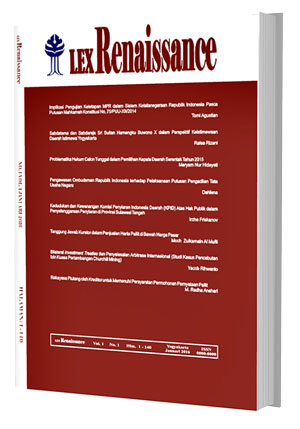Main Article Content
Abstract
The main problem in this writing is, first, how is the right to a decent and healthy environment in the governance of coal Steam Power Plant (PLTU)?; second, how is the future governance concept? The analysis used is descriptive-qualitative method. There are two approaches to be used in this research, namely the legal approach and the case approach. The results of this study conclude that all the regulations that form the basis of coal PLTU have not provided protection and fulfillment of the right to a decent and healthy environment. The concept of future regulation can be seen from three aspects, namely legal substance, legal culture, and law enforcement. From the aspect of its legal substance, it can be seen that there is no clear and firm regulation regarding coal PLTU, it also requires an instrument on the location and the Clean Air Act. For the legal culture, it is more focused on sustainable and environmentally friendly development. As for the law enforcement, there are still some regulations that are not implemented by the company concerned, for example in coal mining.
Keywords
Article Details
Authors who publish with this journal agree to the following terms:
a. Authors retain copyright and grant the journal right of first publication with the work simultaneously licensed under a Creative Commons Attribution License that allows others to share the work with an acknowledgement of the work's authorship and initial publication in this journal.
b. Authors are able to enter into separate, additional contractual arrangements for the non-exclusive distribution of the journal's published version of the work (e.g., post it to an institutional repository or publish it in a book), with an acknowledgement of its initial publication in this journal.
c. Authors are permitted and encouraged to post their work online (e.g., in institutional repositories or on their website) prior to and during the submission process, as it can lead to productive exchanges, as well as earlier and greater citation of published work (See The Effect of Open Access).References
- Buku
- Ahmad Zein, Yahya, Hak Warga Negara Di Wilayah Perbatasan (Perlindungan Hukum Hak Atas Pendidikan dan Kesehatan), Liberty, Yogyakarta, 2016.
- Muchtar, Masrudi, et.al., Hukum Kesehatan Lingkungan (Kajian Teoritis dan Perkembangan Pemikiran), Pustaka Baru Press, Yogyakarta, 2017.
- Slamet Kurnia, Titon, Derajat Kesehatan Optimal sebagai HAM di Indonesia, PT Alumni, Bandung, 2007.
- Jurnal
- I Made Astra, “Energi dan Dampaknya Terhadap Lingkungan”, Jurnal Meteorologi dan Geofisika, Vol. 11 No. 2, November 2010.
- Rika Erawaty dan Siti Kotijah, “Hak Masyarakat Atas Lingkungan Hidup yang Baik dan Sehat” Risalah Hukum, Vol. 9 No. 1 Juni 2013.
- Sutamihardja, dalam Mira Rosana, “Kebijakan Pembangunan Berkelanjutan Yang Berwawasan Lingkungan Di Indonesia”, Jurnal KELOLA: Jurnal Ilmu Sosial Vol. 1 No. 1 (2018),
- Lapoaran
- Greenpeace, “Internalisasi Dampak dan Biaya Kesehatan dari Pembangkit Listrik Tenaga Uap (PLTU) Batubara di Indonesia”, Laporan, September 2016
- Perundang-undangan
- Undang-Undang Dasar Negara Republik Indonesia Tahun 1945
- Undang-Undang Nomor 32 Tahun 2009 tentang Perlindungan dan Pengelolaan Lingkungan Hidup
- Internet
- https://id.wikipedia.org/wiki/Daftar_pembangkit_listrik_di_Indonesia “Daftar Pembangkit Listrik di Indonesia” Akses tanggal 12 Agustus 2019
- https://news.detik.com/dw/d-4001541/who-7-juta-orang-tewas-tiap-tahun-karena-polusi-udara “WHO: 7 Juta Orang Tewas Tiap Tahun Karena Polusi Udara” Akses 8 Agustus 2019
- https://www.beritamoneter.com/pltu-mendominasi-5697-program-listik-35-000-mw/ akses tanggal 25 Februari 2020
- Khoirullah Thofu “PLTU: ENERGI KOTOR YANG DIHASILKAN PRODUKSI LISTRIK BATUBARA (HULU DAN HILIR)” dalam https://www.lbhbali.or.id/berita/read/121/PLTU:-ENERGI-KOTOR-YANG-DIHASILKAN-PRODUKSI-LISTRIK-BATUBARA--HULU-DAN-HILIR-.html akses tanggal 25 Februari 2020
References
Buku
Ahmad Zein, Yahya, Hak Warga Negara Di Wilayah Perbatasan (Perlindungan Hukum Hak Atas Pendidikan dan Kesehatan), Liberty, Yogyakarta, 2016.
Muchtar, Masrudi, et.al., Hukum Kesehatan Lingkungan (Kajian Teoritis dan Perkembangan Pemikiran), Pustaka Baru Press, Yogyakarta, 2017.
Slamet Kurnia, Titon, Derajat Kesehatan Optimal sebagai HAM di Indonesia, PT Alumni, Bandung, 2007.
Jurnal
I Made Astra, “Energi dan Dampaknya Terhadap Lingkungan”, Jurnal Meteorologi dan Geofisika, Vol. 11 No. 2, November 2010.
Rika Erawaty dan Siti Kotijah, “Hak Masyarakat Atas Lingkungan Hidup yang Baik dan Sehat” Risalah Hukum, Vol. 9 No. 1 Juni 2013.
Sutamihardja, dalam Mira Rosana, “Kebijakan Pembangunan Berkelanjutan Yang Berwawasan Lingkungan Di Indonesia”, Jurnal KELOLA: Jurnal Ilmu Sosial Vol. 1 No. 1 (2018),
Lapoaran
Greenpeace, “Internalisasi Dampak dan Biaya Kesehatan dari Pembangkit Listrik Tenaga Uap (PLTU) Batubara di Indonesia”, Laporan, September 2016
Perundang-undangan
Undang-Undang Dasar Negara Republik Indonesia Tahun 1945
Undang-Undang Nomor 32 Tahun 2009 tentang Perlindungan dan Pengelolaan Lingkungan Hidup
Internet
https://id.wikipedia.org/wiki/Daftar_pembangkit_listrik_di_Indonesia “Daftar Pembangkit Listrik di Indonesia” Akses tanggal 12 Agustus 2019
https://news.detik.com/dw/d-4001541/who-7-juta-orang-tewas-tiap-tahun-karena-polusi-udara “WHO: 7 Juta Orang Tewas Tiap Tahun Karena Polusi Udara” Akses 8 Agustus 2019
https://www.beritamoneter.com/pltu-mendominasi-5697-program-listik-35-000-mw/ akses tanggal 25 Februari 2020
Khoirullah Thofu “PLTU: ENERGI KOTOR YANG DIHASILKAN PRODUKSI LISTRIK BATUBARA (HULU DAN HILIR)” dalam https://www.lbhbali.or.id/berita/read/121/PLTU:-ENERGI-KOTOR-YANG-DIHASILKAN-PRODUKSI-LISTRIK-BATUBARA--HULU-DAN-HILIR-.html akses tanggal 25 Februari 2020




